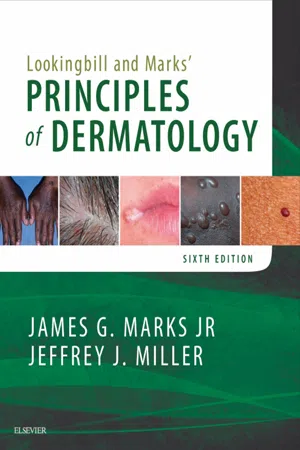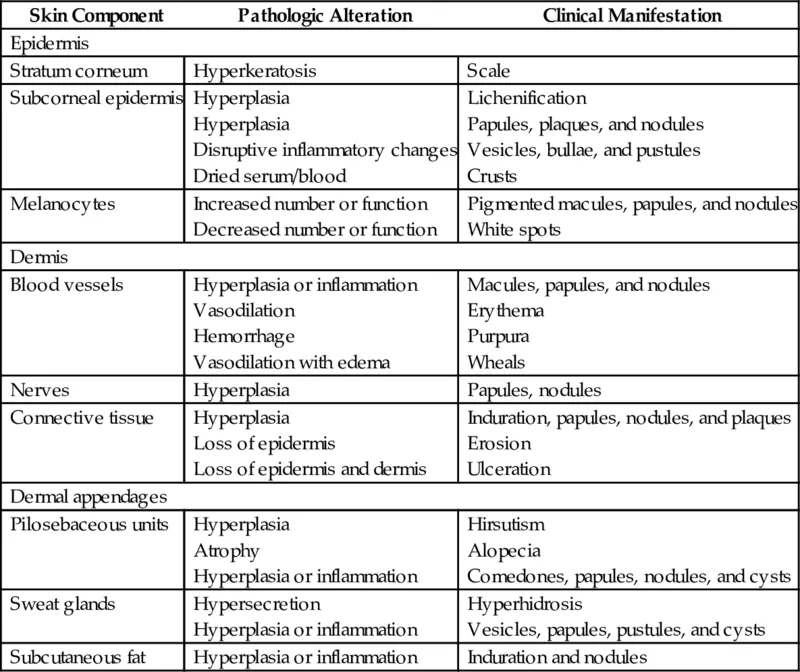
Lookingbill and Marks' Principles of Dermatology E-Book
- 336 pages
- English
- ePUB (mobile friendly)
- Available on iOS & Android
Lookingbill and Marks' Principles of Dermatology E-Book
About this book
Intuitively organized by appearance rather than etiology, Lookingbill and Marks' Principles of Dermatology, 6th Edition, by Drs. James G. Marks, Jr. and Jeffrey J. Miller, is a concise, abundantly illustrated everyday reference for dermatologic diagnosis and therapy. It offers expert guidance and overviews of essential information in dermatology, including key points, clinical pearls, differential diagnosis, and tables of first- and second-line treatments. Superb clinical photographs, full-color histopathology images, and corresponding cross-sectional line diagrams provide details on cause and condition.- Provides self-assessment case reviews to test mastery of important material, therapy options in highlighted boxes, and additional photos of uncommon presentations at the end of each chapter.- Helps you arrive at an accurate differential diagnosis with numerous tables that rank skin diseases according to frequency of incidence and highlight clinical features.- Features new and expanded evidence-based treatment tables to keep you up to date with fast-changing treatments in dermatology and guide you toward the best treatments for your patients.- Offers new coverage of common drug eruptions, as well as the latest therapies for common, difficult-to-treat skin disorders, such as acne, psoriasis, and eczema.- Includes a more diverse range of skin color patient images throughout.- Expert Consult™ eBook version included with purchase. This enhanced eBook experience allows you to search all of the text, figures, and references from the book on a variety of devices.
Frequently asked questions
- Essential is ideal for learners and professionals who enjoy exploring a wide range of subjects. Access the Essential Library with 800,000+ trusted titles and best-sellers across business, personal growth, and the humanities. Includes unlimited reading time and Standard Read Aloud voice.
- Complete: Perfect for advanced learners and researchers needing full, unrestricted access. Unlock 1.4M+ books across hundreds of subjects, including academic and specialized titles. The Complete Plan also includes advanced features like Premium Read Aloud and Research Assistant.
Please note we cannot support devices running on iOS 13 and Android 7 or earlier. Learn more about using the app.
Information
Introduction


Structure and Function of the Skin
Epidermis
| Function | Responsible Structure |
| Barrier | Epidermis |
| ● Physical | ● Stratum corneum |
| ● Light | ● Melanocytes |
| ● Immunologic | ● Langerhans cells |
| Tough flexible foundation | Dermis |
| Temperature regulation | Blood vessels |
| Eccrine sweat glands | |
| Sensation | Nerves |
| Grasp | Nails |
| Decorative | Hair |
| Unknown | Sebaceous glands |
| Insulation from cold and trauma | Subcutaneous fat |
| Calorie reservoir | Subcutaneous fat |
Table of contents
- Cover image
- Title page
- Table of Contents
- Copyright
- Preface
- Preface to the First Edition
- Acknowledgements
- Dedication
- Section 1: Principles of Dermatology
- Section 2: Growths
- Section 3: Rashes with Epidermal Involvement
- Section 4: Dermal Rashes
- Section 5: Ulcers
- Section 6: Hair and Nails
- Section 7: Mucous Membrane Disorders
- Section 8: Diagnosis by Symptom
- Index
